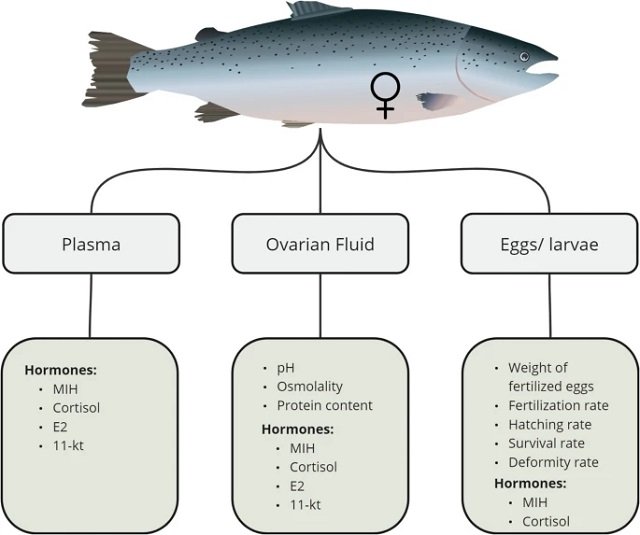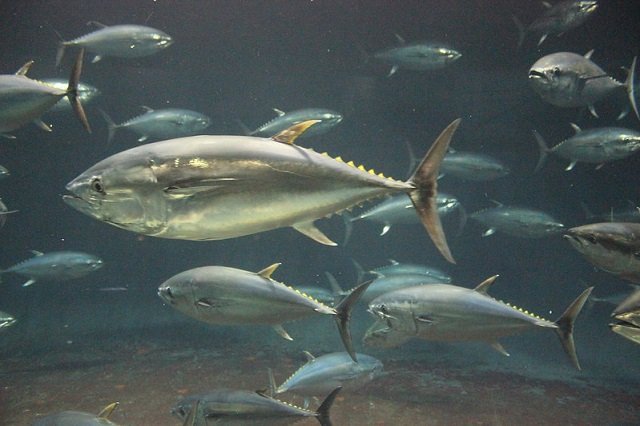
A recent study has raised alarms in the Atlantic salmon industry by identifying a potential cause for the decrease in egg quality and quantity: the vaccination protocol applied to broodstock in their juvenile stage.
The production of high-quality eggs is the cornerstone for the success of any Atlantic salmon (Salmo salar) farming operation. For years, the Norwegian salmon industry has optimized the control of final maturation by manipulating temperature and photoperiod, leaving ovulation problems behind. However, in recent stripping seasons, a concerning issue has emerged: “abnormal ovulation,” characterized by the incomplete release of eggs from the gonads.
This phenomenon has caused a notable reduction in the production of eggs available for fertilization and an alarming variability in their quality, especially towards the end of the stripping season. An observational study, published in the journal Aquaculture International by scientists from the Norwegian University of Science and Technology and Lerøy Seafood Group AS, delved into this problem to explore its causes and impact, and its findings point to a common but understudied management practice in broodstock: vaccination.
The problem: when eggs are not fully released
The research focused on two consecutive stripping seasons, 2021 and 2022, following different broodstock strains.
In the 2021 season, researchers observed a strain (referred to as “strain A 21”) that suffered from severe abnormal ovulation. According to the study, the eggs seemed “stuck” in the gonads, making it difficult to determine the optimal time for stripping. This forced producers to extend the stripping season from the usual 4-6 weeks to 9 weeks. The consequences were drastic: the fertilization rate plummeted from a median of 97% in the first week to only 25% by the ninth.
For the 2022 season, producers made management decisions informed by previous experience. Researchers monitored the same strain (“strain A 22”) and a new one (“strain B 22”). Strain A 22 again showed negative trends, although they were less severe thanks to management adjustments. In contrast, strain B 22 showed stable results consistent with what is expected for commercial Atlantic salmon production.
The key difference: the vaccination protocol
The study clarifies that its objective is not to compare the genetic performance of the strains but to investigate the differences in the treatment the broodstock received. The main distinction identified was the vaccination protocol applied at the parr stage:
- Strains A (21 and 22): Received two intraperitoneal vaccines simultaneously: one oil-based (Alpha Ject Micro 6) and one water-based (Alpha ERM Salar).
- Strain B 22: Received a single oil-based intraperitoneal vaccine (Alpha Ject 5-3).
Given that injectable vaccines can cause inflammatory reactions such as adhesions and may contain endocrine disruptors, the researchers hypothesized that this dual-vaccination protocol was the primary cause of the observed abnormal ovulation.
Stay Always Informed
Join our communities to instantly receive the most important news, reports, and analysis from the aquaculture industry.
Results: the measurable impact on production and egg quality
The collected data showed clear and consistent differences between the strains, supporting the vaccination hypothesis.
Lower production, viability, and more variability in strain A
- Egg output: The average egg output per female decreased significantly throughout the season in the A strains, while in strain B it remained stable and at higher levels.
- Fertilization and survival rates: The A strains showed a constant decline in fertilization, hatching, and survival rates throughout the weeks. Strain B, on the other hand, maintained high and stable fertilization and hatching rates throughout its season.
- Variability: One of the biggest commercial challenges is unpredictability. The A strains showed enormous variability in egg quality among individuals, a pattern that became more pronounced as the weeks went on, while strain B was much more homogeneous.
Chemical clues: what the ovarian fluid revealed
The analysis of the fluid surrounding the eggs offered key clues about the deterioration in quality:
- pH: In the A strains, the ovarian fluid pH decreased throughout the season, a known indicator of aging and poor quality (overripening). The study reports a strong positive correlation: the higher the pH, the higher the fertilization rate.
- Proteins: The protein content in the ovarian fluid increased over time in the A strains, which is associated with egg degeneration. The correlation here was negative: the higher the protein content, the lower the fertilization.
- Hormones: Researchers observed that females producing poor-quality eggs had higher plasma levels of estradiol (E2). Furthermore, good-quality eggs came from females with higher levels of the maturation-inducing hormone (MIH). Notably, markedly higher cortisol levels were found in the ovarian fluid of poor-quality egg batches.
How can a vaccine cause this effect?
The study’s authors propose two main mechanisms, which are not mutually exclusive, to explain how a dual-vaccination protocol could interfere with ovulation.
- Physical adhesions from inflammation: Intraperitoneal vaccines are known to cause inflammatory reactions that can lead to visceral adhesions. A previous study had already reported that about 40% of vaccinated salmon developed adhesions in the gonadal region. The simultaneous administration of two vaccines, as in strain A, involves a larger injection volume, which likely increases the extent of the inflammation area and the formation of scar tissue. These adhesions could be physically preventing the normal and complete release of eggs from the ovaries into the abdominal cavity.
- Interference by endocrine disruptors (EDs): The vaccines used contain formaldehyde as an inactivator, a substance recognized as an endocrine disruptor (ED). The double dose applied to strain A meant double the exposure to formaldehyde at a single time. EDs can alter reproduction by mimicking sex hormones, and their effects may not manifest until much later in the fish’s life. Studies in other species have linked formaldehyde exposure to the degeneration of ovarian follicles and lower embryo viability.
Conclusions and implications for the salmon industry
The findings of this study strongly suggest that abnormal ovulation and the consequent loss of egg quality in Atlantic salmon are associated with the vaccination protocol applied during the parr stage. The problem does not seem to be a particular vaccine, but rather the simultaneous administration of both, which magnifies both the inflammatory response and the exposure to potential endocrine disruptors.
This research underscores the critical need to pay more attention to vaccination protocols in the management of future broodstock. Although research on the effects of vaccination on broodstock is scarce and expensive, the results open the door to a practical solution.
A possible mitigation strategy, suggested by the authors, would be to administer both vaccines sequentially at different times. This approach would reduce the injection volume and the amount of formaldehyde introduced at one time, potentially lessening the observed negative effects without compromising sanitary protection. Future studies directly comparing these administration methods will be key to validating this hypothesis and optimizing the health and reproductive performance of farmed salmon.
Contact
Luciana Alves Musialak
NTNU Department of Biology, Norwegian University of Science and Technology, Centre of Fisheries and Aquaculture (SeaLab)
Trondheim, Norway
Email: luciana.a.musialak@ntnu.no
Reference (open access)
Alves Musialak, L., Finstad, B., Kristensen, E. et al. Decrease in egg quality due to abnormal ovulation in Atlantic salmon (Salmo salar). Aquacult Int 33, 393 (2025). https://doi.org/10.1007/s10499-025-02067-9
Editor at the digital magazine AquaHoy. He holds a degree in Aquaculture Biology from the National University of Santa (UNS) and a Master’s degree in Science and Innovation Management from the Polytechnic University of Valencia, with postgraduate diplomas in Business Innovation and Innovation Management. He possesses extensive experience in the aquaculture and fisheries sector, having led the Fisheries Innovation Unit of the National Program for Innovation in Fisheries and Aquaculture (PNIPA). He has served as a senior consultant in technology watch, an innovation project formulator and advisor, and a lecturer at UNS. He is a member of the Peruvian College of Biologists and was recognized by the World Aquaculture Society (WAS) in 2016 for his contribution to aquaculture.




